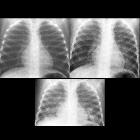Endogenous lipoid pneumonia

Endogenous lipoid pneumonia, also known as idiopathic lipoid pneumonia, is one of the two types of lipoid pneumonias. It is also known as “cholesterol pneumonia” or “golden pneumonia”
Please refer to the main article for a broad discussion, including clinical presentation, radiographic features and treatment and prognosis.
Terminology
The more classic "exogenous type" of lipoid pneumonia is most commonly seen in people who aspirate mineral oil. The lesser known and more common "endogenous type" is the result of localized accumulation of lipid-laden macrophages within alveoli distal to an obstructed airway.
Epidemiology
Its estimated prevalence is around 1-2.5% of autopsies.
Pathology
Endogenous lipoid pneumonia occurs in the setting of airway obstruction. The obstruction results in the accumulation of debris of cellular breakdown, which includes cholesterol from destroyed alveolar walls. These lipids are difficult to digest and the macrophages, which attempt to phagocytose them, accumulate within the alveolar spaces.
Etiology
The classic scenario is in the setting of obstruction by a tumor, bronchiolitis obliterans or after chemotherapy or radiation. Other reported associations include:
Siehe auch:

 Assoziationen und Differentialdiagnosen zu endogene Lipidpneumonie:
Assoziationen und Differentialdiagnosen zu endogene Lipidpneumonie:

